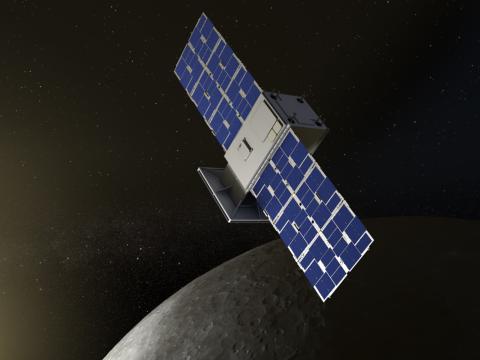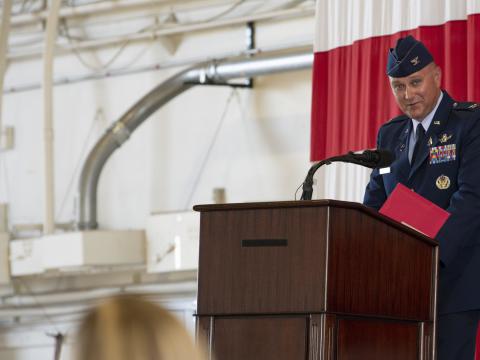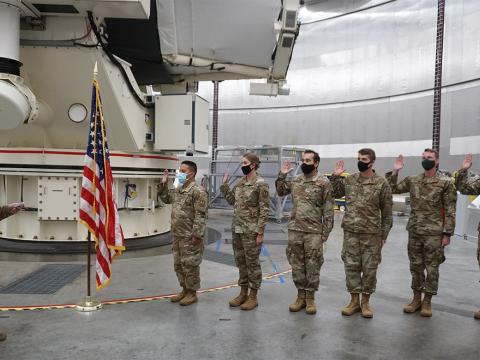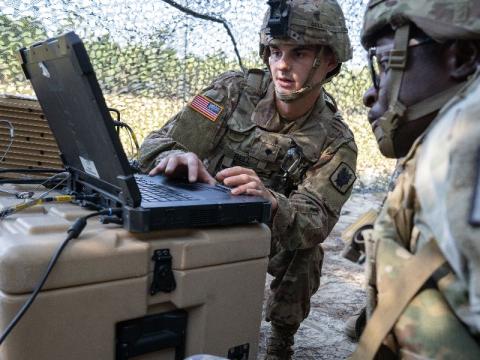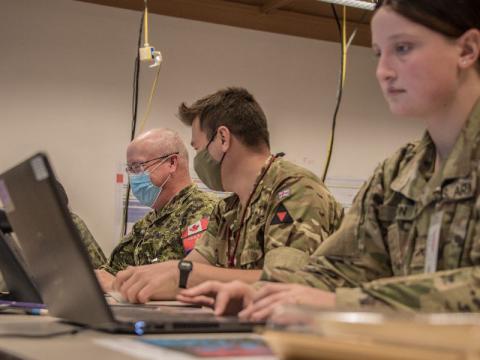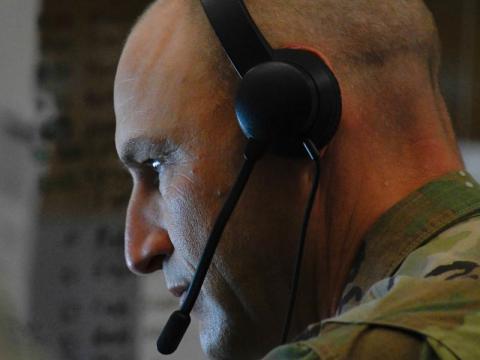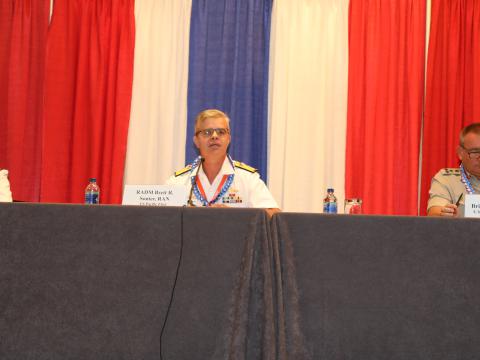JFCOM Implements Transition Plan
Gen. Raymond T. Odierno, USA (c), commander, U.S. Joint Forces Command (JFCOM), joins in one of the discussions during a six-day political-military Strategic Decision Making Exercise at the U.S. Army War College, Carlisle Barracks, Pennsylvania. Gen. Odierno toured the college to see how senior leaders learn strategic and operational interagency processes, crisis action planning, resourcing and multinational coordination.
After nearly 12 years as the joint force developer, the command takes jointness to the next level. 
The combatant command that propelled U.S. military transformation now is in the midst of a revolutionary transition of its own. U.S. Joint Forces Command, scheduled to be disestablished by the end of August, is making this journey led by its commander, Gen. Raymond T. Odierno, USA. Gen. Odierno is applying the tactical expertise he gained while leading U.S. troops in Iraq from combat to sustainment operations to the portentous task of evolving his command into a completely new organization. Guided by the plans he and his staff developed, the general now is executing the implementation stage to make the transition as smooth as possible.
Closing Joint Forces Command (JFCOM), Norfolk, Virginia, in a judicious manner is a top priority. Plans began by carefully examining the command’s core functions to determine how to retain jointness over time. The focus now is on developing a new organization that will concentrate on three major areas: joint individual and collective training, joint concept development, and joint doctrine development. These will be underpinned by modeling and simulation as well as some experimentation.
The Joint Staff J-7 will lead the new organization, which physically will be located at the existing Joint Warfighting Center, Suffolk, Virginia, with a possible name change to the Joint and Coalition Warfighting Center. The organization will comprise the Training Directorate, Synchronization/Integration Directorate and Joint Development Directorate; personnel in these directorates will meld their work and ideas to facilitate better coordination. The general says this approach will ensure that the organization can stay ahead and, in concert, focus on the development of doctrine, training and concepts that replicate current and future environments. It also will be designed to reduce bureaucracy and decrease the number of stovepipes that have emerged over time. “I believe this new organization will be more efficient and effective,” Gen. Odierno states.
An equally important role of this new organization will be to determine how it best can fulfill its mission as a joint force provider. “We’ve improved significantly over the years in this area. They [JFCOM personnel] have come up with systems and capabilities that help to better identify how we improve use of the joint force to meet our requirements in Iraq and Afghanistan,” he notes. This part of the organization will fall under the Joint Staff J-3, which will work on fulfilling requirements as they come in from the field.
Gen. Odierno emphasizes that the organization in Suffolk is a “completely new organization. This [transition] is not only evolutionary but also somewhat revolutionary, bringing this together and trying to gain some efficiencies and effectiveness. I think if it’s done appropriately—which we are focused on—it will be more effective and deliver better products to the combatant commands and services. You don’t need a four-star command to facilitate this anymore because in reality, by Title X, the chairman is responsible for jointness. We were here to facilitate that in a time when we weren’t joint at all. We’ve accomplished that task,” Gen. Odierno says.
The general is no stranger to JFCOM or monumental transitions. He shares that as the commanding general of U.S. Forces–Iraq he benefited from many of the capabilities JFCOM developed. The combatant command assisted in training at the large headquarters in Iraq and developed concepts that had him and his staff seeing the joint environment in different ways. For example, the use of information operations and the whole-of-government approach helped his forces in very complex environments. In addition, JFCOM helped assess intelligence, surveillance and reconnaissance practices to determine how to make them more efficient and effective.
When the focus and work shifted from counterinsurgency operations to stability operations in Iraq, JFCOM conducted a multifaceted study to gather lessons learned. The study included personnel touring throughout Iraq and taking a hard look at how the transition was being handled. “Now, when we do this [move to stability operations] in Afghanistan in a year or two, we will be able to determine how these lessons learned translate to Afghanistan,” Gen. Odierno states.
Personnel from JFCOM assisted in improving sustainment operations by helping Gen. Odierno and his staffs flatten its headquarters organization in Iraq and decrease its footprint by looking at joint functions. This assessment helped reduce the size of the U.S. force in Iraq, the general states.
In addition, JFCOM played a major role in introducing the Joint Urban Fires Prototype. When U.S. military forces in Iraq were concerned about how to conduct joint fires in an urban environment, JFCOM came through with experimentation and conclusions that provided doctrine, tactics, techniques and procedures to accomplish the task.
When U.S. Atlantic Command became U.S. Joint Forces Command in October 1999, jointness existed only as a buzzword. Today, 1st Lt. Ruby Lee, USA, and JFCOM civilian employees review imagery systems that are part of the Joint Battlespace Awareness Intelligence, Surveillance and Reconnaissance (ISR) Integration Capability (JBAIIC), Fort Huachuca, Arizona. The JFCOM J-2/Joint Intelligence Operations Center and the Naval Postgraduate School Information Sciences Department are partnering to make ISR data available immediately to all joint and coalition warfighters.
JFCOM also helped Gen. Odierno command forces in Iraq that experienced problems with standardization of the Joint Terminal Attack Controller (JTAC) from the U.S. Air Force. Specifically, in 2008 the combatant command standardized the JTAC concept development and put training programs into place that assisted not only U.S. forces but also partner nations in the coalition. “It was a joint, combined effort to bring JTAC support to the lowest level possible,” Gen. Odierno says. 
The general explains that his mission in both Iraq and at JFCOM is to implement change, which is always a challenge. “You can’t just order change. That’s not good enough,” he says.
Instead, a leader must persuade many stakeholders buy into the change, explain the requirements so that all personnel understand not only the “why” but also “the why this is important.” The leader must point out the benefits of the change and give the staff members the opportunity to offer their input. This helps ensure that all personnel support whatever changes the leader is making. “You may never get buy-in from the entire staff, but they understand commander’s intent. If you allow them input and let them provide better ways to achieve it, you build momentum behind the effort,” the general says. If this approach is not taken, change can be very difficult, he adds.
One of the largest changes that Gen. Odierno led was the surge of the number of troops in Iraq. “Many people believed that it would not be effective. But I felt adamant that it was the right thing to do when it was not a popular opinion. I was adamant about the environment I was entering; I thought I had a good understanding about it. I thought it was what we needed to potentially turn this environment around. Then, a few months later when [U.S. Army] Gen. [David H.] Petraeus came on board, we wanted that to be in place so he could take it forward,” he explains.
These changes led to signing the security agreement that changed the dynamics completely inside Iraq, he states. “We now recognized Iraq as a sovereign nation. We developed the bilateral relationship between Iraq and the United States in the longer-term relationships with engagement with Iraq. We had built confidence, and the trust that we had developed allowed us to work through that complex time, in my mind, in a very smooth way. Frankly, much smoother than I expected,” he states.
Key people in the United States did not believe that a decrease in the number of troops in Iraq could occur without sacrificing security, the general shares. But in that situation, just as at JFCOM today, he had built a detailed plan, rehearsed it and knew what his troops had to do. “Thinning the lines” took place over 18 months to two years, “and nobody really saw us leave. As smoothly as that went, it surprised everyone,” the general relates.
As Gen. Odierno leads the transformational change of JFCOM taking place over the next several months, he is transforming on the fly. Affected command personnel, scheduled for relocation to Suffolk by March 2012, continue to work diligently on several projects. For example, earlier this year the command conducted its largest joint training event ever, Unified Endeavor 11-2 Operation Enduring Freedom mission rehearsal exercise. JFCOM simultaneously connected the U.S. Army’s Battle Command Training Program, Fort Hood, Texas; the U.S. Marine Corps’ Air-Ground Task Force Staff Training Program, Camp Lejeune, North Carolina; and NATO’s Joint Force Training Center, Bydgoszcz, Poland.
“This was the first time we were able to do this. We built this up over a very long period of time. We are able to replicate what they would see as they deploy to Afghanistan as major commands,” he states. Investments in this event have been made over several years, and now those investments were able to come to fruition. The event was based on the Joint National Training Capability, or JNTC, which over the years has developed an environment that connects several hundred locations and joins 11 unique military training networks, including military, coalition and interagency partners. The general shares that JFCOM plans to conduct a similar but larger event next month that will support another exercise for Afghanistan.
Another JFCOM focus area that refuses to stand still while transformation takes place is its work on unmanned aerial systems (UASs). At the end of last year, JFCOM conducted an exercise to test joint tactics, techniques and procedures relevant to combating adversaries’ UASs. “We spent a lot of time looking at what we’re doing, but we have not spent a lot of time looking at the adversaries and how they’re using UASs,” Gen. Odierno states. “We found out that we have to do much more in this area because it could be a potential large game-changer in operations, and we have not focused on it. So the exercises and data collection we did show that we must focus more attention in this area and come up with counter systems and tactics, techniques and procedures to assist us in going after this particular problem now and into the future.”
The importance of information operations continues to increase, boosting the importance of JFCOM’s Information Operations Range. This secure distributed network integrates operators and targets from traditional kinetic operations and the cyber realm. “In a technically representative environment, we are trying to determine how information operations can impact commanders’ operations,” Gen. Odierno says. “How does it get integrated with other operational techniques? We have to test the capability and set how we must think about this.
“We’ve been working this very hard with each combatant command, service, coalition member and our joint team users. Information from events and exercises is shared. Each service, combatant command and coalition partner creates its own set of lessons learned, and then the joint lessons learned analysis team collects this data to review as JFCOM develops new concepts and doctrines moving forward,” the general explains. Over the past year, 12 interagency/service testing events and 13 experimentation projects in this specific area also have taken place.
WEB RESOURCE
U.S. Joint Forces Command: www.jfcom.mil/about/facts.html
